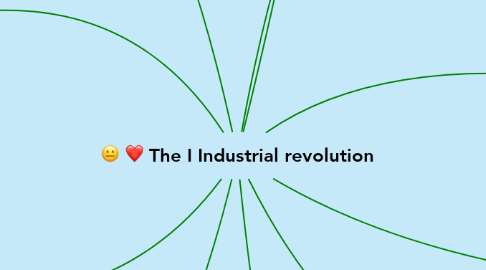
1. It started in Britain during the end of the 18th century
1.1. Why?
1.1.1. The easy availability of coal and iron
1.1.2. The avilability of navigable rivers and canals that provided rapid trasportation of both raw materials and finisched products
1.1.3. Its colonies gave England access to enourmus markets
1.1.4. Financial stability
1.1.5. Government stability
2. Agricolture innovations
3. The clothing of ordinary people changed with the introduction:
3.1. Linen underwear
3.2. Stockings
3.3. Ribbons
3.4. Hats
4. Technological innovation
4.1. Steam engine
4.2. James Hargreaves's Spinning Jenny increased spinning efficiency
4.3. Mass consumption of machine-made goods started
4.4. Edmund Cartwright's loom linked cloth manufacture to water and steam power
4.5. Robert Fulton
4.5.1. Steamboat
4.5.2. Sped water transportation
4.6. Thomas Telford and John McAdam
4.6.1. Macadamized roads
4.6.2. Improved roads
4.7. George Stephenson
4.7.1. Locomotive
4.7.2. Fast land transport of peopleand goods
5. Adam Smith supported economic liberalism, according to which industry is the major source of income
5.1. His "laissez faire " theory was against intervantion on free market from the govermente
5.1.1. Smith believed in the existence of an "invisible hand" in the economy
5.1.1.1. The market regulates itself with price competition
6. Population growth
6.1. cheap man-power avaible
7. Consumption for pleausure
7.1. Tabacco
7.2. Tea
7.3. Coffe
7.4. Sugar
7.5. Alcohol
8. The advent of the factory system
8.1. People shifted from the rural South to the industrialised North and Midlans
8.1.1. In small towns, the "Mushroom towns"
8.1.1.1. The air and the water were polluted by smoke and filth
8.2. Factories were often family run
8.3. Women and children were prized by employers because they could be paid less and were easier to control
8.3.1. The fact that the children were so small meant they move more easly in mines
8.3.2. Long working hours, about 12-15 a day
8.3.3. Low wages
8.3.4. Precarious work
8.3.5. strikes
8.3.6. worker leagues
9. Two classes entered in conflict
9.1. The working class, promoting socialism
9.2. The bourgeois class promoting capitalism
10. restructuring of the transport system
10.1. New roads
10.2. Railways
10.2.1. steam locomotives made rail transport more efficient
10.3. infrastructures
10.3.1. New bridges and tunnels were built using iron
